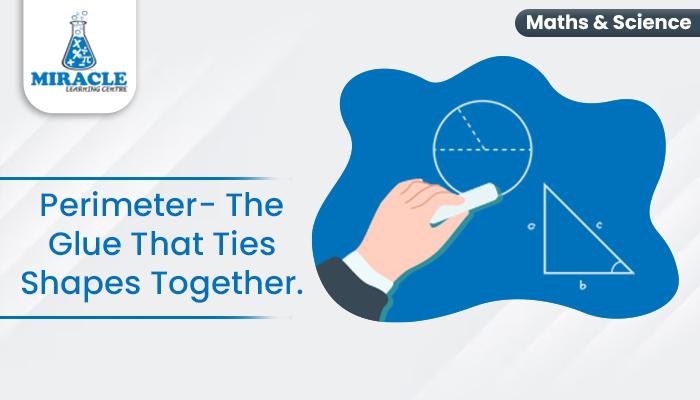The word “perimeter” is frequently used in the context of geometry, but what does it actually mean? The term “perimeter” refers to the boundary or outer edge of a two-dimensional form and is a fundamental idea in geometry. Understanding perimeter is crucial while developing a garden, construction or even just trying to determine how much fencing you need for your property. At Miracle Learning Centre, we’re dedicated to helping students at all levels by demystifying complex mathematical ideas like perimeter and making them accessible and clear. We want to cultivate a strong appreciation for mathematics in our pupils through our specialized maths tuition centres, enabling them to flourish in this vital area of study. Come explore the specifics of perimeter with us!
What is Perimeter?
Perimeter is the measurement of the total distance around the outer edge of a shape. It is essentially the sum of all the sides or segments that enclose the shape. Think of it as tracing the outline of a shape with a length of string and then measuring that string to find the perimeter.
How to Calculate Perimeter?
The method to calculate perimeter varies depending on the type of shape you are dealing with. For regular shapes like squares and rectangles, you can simply add up the lengths of all sides since they are equal.
For irregular shapes, the process is slightly more complex. Break down the shape into smaller, more manageable parts, and then sum the lengths of these parts. This can be done using measuring tools or mathematical formulas, depending on the shape’s complexity.
Units of Perimeter
Perimeter can be expressed in various units depending on the context and the size of the shape. Common units include millimeters (mm), centimeters (cm), meters (m), kilometers (km), inches (in), feet (ft), and miles (mi). The choice of unit depends on the size of the object you’re measuring.
For example, you would likely use centimeters or meters for a room’s perimeter but might use kilometers or miles to measure the perimeter of a large piece of land.
Formula of Perimeter
Different shapes have specific formulas to calculate their perimeters. Here are some common shapes and their perimeter formulas:
- Rectangle: Perimeter (P)= 2 * (length + width) =2*(l + w)
- Square: Perimeter (P)= 4 * Side length
- Triangle: Perimeter (P)= Sum of the lengths of all three sides
- Circle: Perimeter (Circumference) (P)= 2 * π * radius(r) or π * diameter(d)
- Regular Polygon: Perimeter (P)= number of sides * side length
- Irregular Shapes: For complex or irregular shapes, break them down into simpler shapes and calculate the perimeter of each part. Then, sum up the perimeters of all parts.
It’s important to remember the specific formula for the shape you are working with to accurately calculate the perimeter.
Difference between Perimeter and Area
While perimeter measures the outer boundary of a shape, area measures the space enclosed within the boundary. In other words, perimeter is concerned with the length of the outline, while area is concerned with the space inside that outline.
Example:
Imagine you have a rectangular room that measures 4 meters in length and 3 meters in width. Calculating the area of the room would tell you how many square meters of paint you need to cover the walls:
Area = Length × Width = 4 m × 3 m = 12 square meters.
Now, let’s consider the perimeter of the same room. If you’re planning to install crown molding around the room’s top edge (excluding the doors and windows), you’d calculate the perimeter:
Perimeter = 2 × (Length + Width) = 2 × (4 m + 3 m) = 2 × 7 m = 14 meters.
In this example, area and perimeter serve different purposes: area helps you determine the paint quantity, while perimeter aids in figuring out how much moulding to purchase.
In our maths tuition centre, we delve deeper into such examples and tackle a wide array of questions related to area and perimeter. If you want to enhance your math skills and gain a comprehensive understanding of these concepts, consider joining our math tuition program. We’re here to help you excel in mathematics!
Real-Life Applications of Perimeter
Perimeter has numerous real-life applications across various fields:
- Construction: Builders use perimeter calculations to determine the amount of material needed for constructing walls, fences, and flooring.
- Gardening: Gardeners use perimeter to decide how much fencing or border material is required for a garden bed or lawn.
- Home Improvement: When remodeling rooms, homeowners use perimeter to estimate the amount of paint or wallpaper needed for the walls.
- Landscaping: In landscape design, determining the perimeter helps with planning walkways, pathways, and hardscape features.
- Agriculture: Farmers use perimeter measurements to calculate the amount of fencing required for their fields or pastures.
- Architecture: Architects rely on perimeter calculations when designing building layouts and determining space allocation.
- Real Estate: Real estate professionals use perimeter measurements to assess property boundaries and lot sizes.
- Sports: In sports like track and field, the perimeter of the track is essential in determining race distances.
Before we conclude, let’s address the importance of proper guidance in understanding and mastering the formulas of perimeter. Students often explore various ways to grasp these concepts, but sometimes, it can be challenging to remember all the details. This is where maths tuition comes into play as the most effective solution.
At Miracle Learning Centre, we recognize the value of structured learning and provide a platform to help students overcome these hurdles. Our experienced tutors employ a comprehensive approach, explaining the topic with numerous examples, ensuring that students not only understand but also retain the formulas of perimeter. With the support of our maths tuition centre, mastering geometry becomes an achievable goal, opening doors to countless opportunities in the world of mathematics and beyond.
Conclusion
In conclusion, perimeter is a fundamental concept in geometry that holds the key to measuring the boundary of two-dimensional shapes. Understanding how to calculate perimeter, the units involved, and the specific formulas for various shapes is essential knowledge. It may appear as a basic concept, but its applications span a wide range of fields, from construction and architecture to gardening and sports. To excel in topics like perimeter in geometry, consider joining our maths tuition centre today. We are here to guide you on your mathematical journey and help you unlock your full potential.


